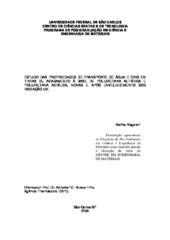| dc.contributor.author | Magaton, Marina | |
| dc.date.accessioned | 2016-06-02T19:12:43Z | |
| dc.date.available | 2007-08-20 | |
| dc.date.available | 2016-06-02T19:12:43Z | |
| dc.date.issued | 2005-08-26 | |
| dc.identifier.citation | MAGATON, Marina. Study of water and ion transport in painting systems based on polyurethane resins/iron oxide, before and after ageing under radiation UV.. 2005. 185 f. Dissertação (Mestrado em Ciências Exatas e da Terra) - Universidade Federal de São Carlos, São Carlos, 2005. | por |
| dc.identifier.uri | https://repositorio.ufscar.br/handle/ufscar/943 | |
| dc.description.abstract | The present work has as objective the comparative study between anticorrosive painting systems with two types of vehicle - aliphatic polyurethane and acrylic polyurethane - loaded with different concentrations of iron oxide of
the red type (OFV) and the micaceous type (OFM), new and after aging under UV radiation. A set of fourteen different painting systems was studied, that vary between itself for the type used vehicle, as well as for the type and
concentration of iron oxide added. Samples in form of free films had been submitted the assays of transport and sorption of water, ionic transport, Scanning Electronic Microscopy (MEV) and Atomic Force Microscopy (AFM). As general conclusion, the results show that for all the analyzed systems, the dispersion of pigments is below of the desired one, with formation of porous aggregate of the solids particles. This fact is evinced from the results of transport and water sorption, where an increase of the solubility of the systems with the increase of the pigment concentration was observed, and also, from images of the morphology of the samples, obtained from MEV analysis. The aged systems had presented permeabilities higher than those for the new films,
in all the range of concentrations, being that in the case of the loaded systems with micaceous iron oxide the effect of the aging was small, in comparison to of the red iron oxide. The effect of the aging also can be observed through the
images obtained from MEV analysis, for all the systems, as well as from images of MFA obtained for two specific systems. Assays of ionic transport had been carried through for four selected systems, and had corroborated with the results
of transport and sorption of water. In this direction, four systems between those studied had been selected, that the carried through assays had presented better performances in all: aliphatic polyurethane with 5% of OFM and 35% of
OFV, and acrylic polyurethane, with 5% and 35% of OFM. | eng |
| dc.description.sponsorship | Universidade Federal de Sao Carlos | |
| dc.format | application/pdf | por |
| dc.language | por | por |
| dc.publisher | Universidade Federal de São Carlos | por |
| dc.rights | Acesso Aberto | por |
| dc.subject | Polímeros | por |
| dc.subject | Tintas | por |
| dc.subject | Propriedade de transporte | por |
| dc.subject | Compósitos poliméricos | por |
| dc.title | Estudo das propriedades de transporte de água e íons em tintas de acabamento à base de poliuretana alifática e poliuretana acrílica, novas e após envelhecimento sob radiação UV. | por |
| dc.title.alternative | Study of water and ion transport in painting systems based on polyurethane resins/iron oxide, before and after ageing under radiation UV. | eng |
| dc.type | Dissertação | por |
| dc.contributor.advisor1 | Ruvolo Filho, Adhemar Colla | |
| dc.contributor.advisor1Lattes | http://genos.cnpq.br:12010/dwlattes/owa/prc_imp_cv_int?f_cod=K4787583A0 | por |
| dc.description.resumo | O presente trabalho teve como objetivo o estudo comparativo entre sistemas de pintura anticorrosiva com dois tipos de veículo poliuretana alifática e poliuretana acrílica carregados com diferentes concentrações de óxido de ferro do tipo vermelho e do tipo micáceo, novos e após
envelhecimento sob radiação UV. Foi estudado no total um conjunto de quatorze diferentes sistemas de pintura, que variam entre si pelo tipo veículo utilizado, bem como pelo tipo e concentração de óxido de ferro adicionado. Foram utilizadas amostras das tintas em forma de filmes livres, obtidos através
do espalhamento (casting). Os filmes livres foram submetidos a ensaios de transporte e sorção de água, transporte iônico, Microscopia Eletrônica de Varredura (MEV) e Microscopia de Força Atômica (MFA). Como conclusão geral, os resultados obtidos mostram que os sistemas analisados apresentam
boa distribuição de pigmento, contudo a dispersão é aquém da desejada, com a formação de agregados porosos de partículas sólidas. Este fato é evidenciado a partir dos resultados de transporte e sorção de água, onde se
observou um aumento da solubilidade dos sistemas com o aumento da concentração de pigmento, e também, a partir de imagens da morfologia das amostras, obtidas via MEV. Os sistemas após envelhecimento apresentaram permeabilidades acima das obtidas para os filmes novos, em toda a faixa de
concentrações, sendo que no caso dos sistemas carregados com óxido de ferro micáceo o efeito do envelhecimento foi pequeno, em comparação ao óxido de ferro vermelho. O efeito do envelhecimento pode ser também observado através de imagens obtidas via MEV para todos os sistemas, bem
como a partir de imagens de MFA obtidas para dois sistemas específicos. Ensaios de transporte iônico foram realizados para quatro sistemas selecionados, e corroboraram com os resultados de transporte e sorção de água. Neste sentido, foram selecionados os sistemas que apresentaram os
melhores desempenhos em todos os ensaios realizados, quais sejam: poliuretana alifática com 5% de óxido de ferro micáceo e com 35% de óxido de ferro vermelho, e poliuretana acrílica com 5% e 35% de óxido de ferro micáceo. | por |
| dc.publisher.country | BR | por |
| dc.publisher.initials | UFSCar | por |
| dc.publisher.program | Programa de Pós-Graduação em Ciência e Engenharia de Materiais - PPGCEM | por |
| dc.subject.cnpq | ENGENHARIAS::ENGENHARIA QUIMICA::TECNOLOGIA QUIMICA::POLIMEROS | por |
| dc.contributor.authorlattes | http://buscatextual.cnpq.br/buscatextual/visualizacv.do?id=S213796 | por |
